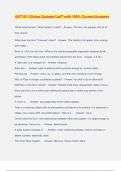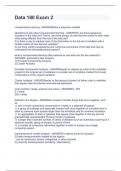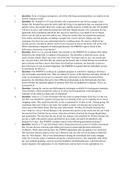Lectures Cognitive Behavioral
Interventions
Laura Braam
Inhoudsopgave
Lecture 1: Exposure and cognitive restructuring.............................................................................................1
Lecture 2: Combined Cognitive-Behavioural Strategies.................................................................................10
Lecture 3: Behavioural and experiential treatment principles in depression..................................................21
Lecture 4: Self-regulation and self-control.................................................................................................... 31
Lecture 1: Exposure and cognitive restructuring
Theoretical background
Classical conditioning – Pavlov
A type of learning in which a stimulus acquires the capacity to evoke a reflexive response
that was originally evoked by a different stimulus.
Before conditioning: unconditioned stimulus unconditioned response
Neutral stimulus no conditioned response
During conditioning: neutral stimulus + unconditioned stimulus unconditioned response
After conditioning: conditioned stimulus conditioned response
Little Albert – anxiety response generalized
After conditioning, the sight of the rat made Albert scream – after a while Albert began to
show similar terrified responses to other stimuli. The fear evoked by the white, furry rat had
generalized to other white, furry things, like Watson’s beard.
Maintenance of fear
We’ve learned so far that classical conditioning can lead to the onset of (pathological) fear
The process of operant conditioning is needed to explain the maintenance of fear
Two-factor model Mowrer
1. Classical conditioning
2. Operant conditioning (avoidant)
,Emotional processing theory
These early learning accounts were expanded by integrating Lang’s concept of the ‘fear
structure’ to create a comprehensive model for understanding pathological anxiety
- The ‘fear-structure’ is an anxiety memory in which representations of stimuli,
responses, and meanings are stored
- In anxiety disorders, stimulus representations are linked to danger and strong
responses
Consequences for therapy
Effective therapy = correct fear-structure
Demands:
- Fear-structure has to be activated (the patient must experience anxiety during
therapy)
- New information, incompatible with old info, must be introduced in fear structure
What is exposure therapy?
- Exposure therapy purposefully generates anxiety by exposing an individual
repeatedly to fear provoking stimuli
- In the absence of repeated aversive outcomes
- Which leads to extinction through inhibitory learning
,Avoidance decreases anxiety level, short term relief. Still high expected anxiety.
In exposure, the anxiety levels will decrease with practicing.
3 types of exposure
- Exposure to external feared stimuli (in vivo exposure)
- Exposure to imaginal stimuli (in vitro/imaginal exposure)
- Exposure to physical (internal) stimuli (interoceptive exposure), focusing on feelings
and sensations in the body
Works for specific phobias, panic disorder, social anxiety disorder, generalized anxiety
disorder, OCD, trauma (PTSD).
, Procedural variations
Massed versus spaced exposure (between session)
Must ET be conducted at its max length? (E.g., 3-4 hours a day, 5 fays a week)
- Pro massed ET: quick improvement enhances motivation / less opportunity for
avoidance
- Pro spaced ET: less return of fear / more acceptable and practical to patients
- Current practice: mostly spaced
Gradual versus intense exposure
Should ET be as intense as possible or gradual (beginning with the least fearful stimulus?)
- Flooding exposes the person to the most anxiety0oroducing stimulus
- Graduated exposure begins with the least fearful stimulus
Pro-flooding: quicker results than graduated ET
Pro graduated ET: less dropout and non-compliance than flooding
Practice: mostly gradual
Attention versus distraction
Distraction – regulates too high levels of anxiety (positive effect on short term), but also acts
as cognitive avoidance (hampering anxiety activation and habituation) negative effect on
long term
The long-term effects of focused attention during ET are better
Therapist-aided versus self-directed ET
Is the aid of another person (therapist/family member) necessary for successful ET?
- Therapist or spouse-aided ET somewhat more effective than self-directed ET
- Practice: involvement of others in first phase of ET
Exposure in vivo just as effective as in vitro?
- In vivo is more effective than in vitro ET. Every therapy should include exposure in
vivo!
- Imaginal exposure to motivate patients to start in vivo exposure and in case of
exposure to special stimuli (e.g., reexperiences in PTSD or fear of flying)
… or in virtual reality.
Example: arachnophobia
Example: fear of moving, scared something is wrong with her spine.
Some new insights on extinction
- Extinction is not unlearning: Pavlovian associations are forever
- Extinction is enhancing inhibitory learning
- Habituation (fear reduction during exposure) is not necessary for therapeutic change
Interventions
Laura Braam
Inhoudsopgave
Lecture 1: Exposure and cognitive restructuring.............................................................................................1
Lecture 2: Combined Cognitive-Behavioural Strategies.................................................................................10
Lecture 3: Behavioural and experiential treatment principles in depression..................................................21
Lecture 4: Self-regulation and self-control.................................................................................................... 31
Lecture 1: Exposure and cognitive restructuring
Theoretical background
Classical conditioning – Pavlov
A type of learning in which a stimulus acquires the capacity to evoke a reflexive response
that was originally evoked by a different stimulus.
Before conditioning: unconditioned stimulus unconditioned response
Neutral stimulus no conditioned response
During conditioning: neutral stimulus + unconditioned stimulus unconditioned response
After conditioning: conditioned stimulus conditioned response
Little Albert – anxiety response generalized
After conditioning, the sight of the rat made Albert scream – after a while Albert began to
show similar terrified responses to other stimuli. The fear evoked by the white, furry rat had
generalized to other white, furry things, like Watson’s beard.
Maintenance of fear
We’ve learned so far that classical conditioning can lead to the onset of (pathological) fear
The process of operant conditioning is needed to explain the maintenance of fear
Two-factor model Mowrer
1. Classical conditioning
2. Operant conditioning (avoidant)
,Emotional processing theory
These early learning accounts were expanded by integrating Lang’s concept of the ‘fear
structure’ to create a comprehensive model for understanding pathological anxiety
- The ‘fear-structure’ is an anxiety memory in which representations of stimuli,
responses, and meanings are stored
- In anxiety disorders, stimulus representations are linked to danger and strong
responses
Consequences for therapy
Effective therapy = correct fear-structure
Demands:
- Fear-structure has to be activated (the patient must experience anxiety during
therapy)
- New information, incompatible with old info, must be introduced in fear structure
What is exposure therapy?
- Exposure therapy purposefully generates anxiety by exposing an individual
repeatedly to fear provoking stimuli
- In the absence of repeated aversive outcomes
- Which leads to extinction through inhibitory learning
,Avoidance decreases anxiety level, short term relief. Still high expected anxiety.
In exposure, the anxiety levels will decrease with practicing.
3 types of exposure
- Exposure to external feared stimuli (in vivo exposure)
- Exposure to imaginal stimuli (in vitro/imaginal exposure)
- Exposure to physical (internal) stimuli (interoceptive exposure), focusing on feelings
and sensations in the body
Works for specific phobias, panic disorder, social anxiety disorder, generalized anxiety
disorder, OCD, trauma (PTSD).
, Procedural variations
Massed versus spaced exposure (between session)
Must ET be conducted at its max length? (E.g., 3-4 hours a day, 5 fays a week)
- Pro massed ET: quick improvement enhances motivation / less opportunity for
avoidance
- Pro spaced ET: less return of fear / more acceptable and practical to patients
- Current practice: mostly spaced
Gradual versus intense exposure
Should ET be as intense as possible or gradual (beginning with the least fearful stimulus?)
- Flooding exposes the person to the most anxiety0oroducing stimulus
- Graduated exposure begins with the least fearful stimulus
Pro-flooding: quicker results than graduated ET
Pro graduated ET: less dropout and non-compliance than flooding
Practice: mostly gradual
Attention versus distraction
Distraction – regulates too high levels of anxiety (positive effect on short term), but also acts
as cognitive avoidance (hampering anxiety activation and habituation) negative effect on
long term
The long-term effects of focused attention during ET are better
Therapist-aided versus self-directed ET
Is the aid of another person (therapist/family member) necessary for successful ET?
- Therapist or spouse-aided ET somewhat more effective than self-directed ET
- Practice: involvement of others in first phase of ET
Exposure in vivo just as effective as in vitro?
- In vivo is more effective than in vitro ET. Every therapy should include exposure in
vivo!
- Imaginal exposure to motivate patients to start in vivo exposure and in case of
exposure to special stimuli (e.g., reexperiences in PTSD or fear of flying)
… or in virtual reality.
Example: arachnophobia
Example: fear of moving, scared something is wrong with her spine.
Some new insights on extinction
- Extinction is not unlearning: Pavlovian associations are forever
- Extinction is enhancing inhibitory learning
- Habituation (fear reduction during exposure) is not necessary for therapeutic change












